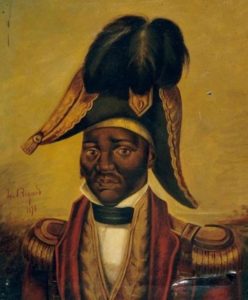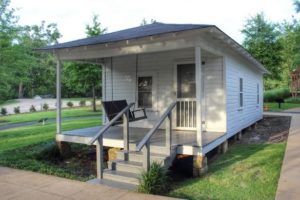
It was on June 1, 1971 – 49 years ago today – that the two-room shotgun house in Tupelo Mississippi in which Elvis Presley (1935-1977) was born was opened to the public as a tourist attraction. The house, located at 306 Old Satillo Drive (today 306 Elvis Presley Drive) was built by Presley’s father Vernon, his grandfather Jesse, and his uncle Vester in 1934 for $180. It was designated a State Historical Site by the Mississippi Department of Archives and History on January 8, 1978, on what would have been Elvis’ 43rd birthday.
The house is but one small step removed from the fabled log cabin birth houses of such American icons as Andrew Jackson, Abraham Lincoln, and Ulysses Grant (and yes, Millard Fillmore). In total, Presley’s birth house can’t occupy much more than 600 square feet.

Behind the front door is the house’s one-and-only bedroom, in which Elvis was born.

Behind the bedroom is the kitchen, and that’s it: a rear door leads to the back yard where the outhouse once stood.
It was a difficult birth for Gladys Presley (1912-1958). Elvis was a twin. He was born some 35 minutes after his identical twin brother, Jesse Garon Presley, who was, tragically, stillborn. The difficult circumstances of the births precluded Gladys from having any more children, so Elvis remained an only child with, according to his mother, “the energy of two people”.

Elvis’ father Vernon Presley (1916-1979) worked as a sharecropper on a farm owned by one Orville Bean, who had loaned Vernon the $180 to build the house. But the times were very tough – it was the midst of the Depression, after all – and Vernon Presley could not make his payments on that loan. In what can only be understood as a genuine Mr. Burns moment, Orville Bean repossessed the house and evicted the Presley family when Elvis was about three years old. The Presleys bounced around Tupelo for the next ten years until November 6, 1948, when Elvis was 13 years old, when they piled into Vernon Presley’s 1939 Plymouth and moved to Memphis.
(As a public service, I would provide the following information. The small, Assembly of God Pentecostal Church – where the Presley family worshipped and where Elvis first heard and sang the gospel music that was the foundation of his musical life – was moved onto the birthplace grounds in 2008. A recently upgraded Elvis museum is also on site. To see all three sites – house, church, and museum – costs $19 for an adult; $15 for a senior [60+]; $9 for kids 7-12; children under 7 are free. Consider a tour when you’re next in Tupelo once our present craziness is over!)
Now, please, I beg your indulgence. In researching this post I came across a body of information that has nothing to do with music but is, nevertheless, a body of info that I found fascinating. Since I generally assume that what I find of interest others will as well, I would share it with you. It has to do with real estate, and heaven knows, after sex and food (perhaps even before sex and food) nothing fascinates many (if not most) of us like real estate.
(A true story. On Thursday, May 14, my wife Nanci and I had a Zoom cocktail hour with our friends Cheryl and Dan Berger, who live just a few hundred yards away and whose kids are good friends of our kids. Dan is a two-time Emmy Award winning sports broadcaster who is in the thick of trying to figure out when professional sports will return; my wife Nanci is a front line pediatrician dealing with, among other things, COVID-19 families; and as for myself, I can be a rather amusing conversationalist, particularly with a martini in me. So what did we talk about? We talked almost exclusively about real estate, as Cheryl is a real estate agent who has managed, somehow, to close multiple listings during the pandemic. The revealing thing is that I was happier talking about home sales than I would have been talking about sports, music, or the pandemic. What does that say about my priorities?
FYI: that was a rhetorical question; please don’t answer.)
So to issues real estate.
The Presley house in Tupelo is what is known as a “shotgun house” (or a shotgun shack, shotgun cottage, or a shotgun hut).

By definition, a shotgun house is a narrow rectangular house, typically no more than around 12 feet wide. Such a house consists of two to five rooms arrayed one behind the other with no hallways between the rooms and with doors at either end of the house. By its nature, the layout of a shotgun house is particularly well suited for hot climates, because by opening both the front and back doors, air will flow directly through the entire house.
The name “shotgun house” gives evidence to the origin of the design. There are still some folks out there who claim that such structures “are called shotgun houses because a bullet fired through the front door would go right out the backdoor without hitting a wall”, though with all due respect we’d observe that a shotgun does not fire a “bullet” but rather, an ever-expanding wedge of pellets. In fact, it appears that the word “shotgun” is an Anglicization of the word “shogun”, which means “God’s House” in a number of West African languages.
This sort of structure came into North America through New Orleans; it came to New Orleans from Haiti; and to Haiti from West Africa. Haitian slaves built their own dwellings, and these dwellings were based on those of their West African homelands: “narrow buildings with gabled entrances, stucco walls, thatched roofs [and] African motifs decorating the exterior framing of their homes.”
It was an epochal, defining historical event that brought the shotgun house from Haiti to North America.

On August 22, 1791, a slave revolt broke out in Saint-Domingue – modern Haiti – against French colonial rule. It was a brutal and prolonged insurrection which finally concluded in 1804 with the so-called “French Massacre of 1804”, a grisly bloodbath that saw most of the remaining French population and French Creoles (or Franco-Haitians) put to the sword by Haitian soldiers under the command of Jean-Jacque Dessalines (1758-1806), who was to become the first ruler of an independent Haiti.
The success of the Haitian Revolution stunned the Western world. It was the most significant slave revolt since that of Spartacus against the Roman Republic between 71 and 73 B.C.E. The organizational competence, resolve, and martial valor displayed by the rebels went against everything whites believed regarding the inferiority of blacks and their inability to attain and then preserve their own freedom. The Haitian Revolution remains the only such uprising to have led to the creation of a sovereign state that was not just free of slavery, but governed by former slaves.
With the advent of the Haitian Revolution in 1791, large numbers of European plantation owners (the majority of which were French) fled Haiti for New Orleans, taking with them what slaves they could. Thousands of other mixed race and free people of color fled to New Orleans as well, altering profoundly the city’s racial demographic by virtually doubling the number of people of full or partial African descent. By 1810, the population of New Orleans was roughly one-third white, one-third slaves, and one-third free people of color (gens de couleur libres), the vast majority of who were refugees from Haiti.
On arriving in New Orleans, these free people of color built for themselves shotgun houses. According to the folklorist John Michael Vlach:
“Haitian émigrés had only to continue in Louisiana the same life they had known in St. Domingue. The shotgun house of Port-au-Prince became, quite directly, the shotgun house of New Orleans.”

In place of African motifs, these émigrés often decorated the exterior of their North American shotgun houses with elaborately detailed, filigreed designs, so-called “gingerbread” trimmings. With their exterior front porches, these shotgun houses were quite different from those of the white Francophone population, the outdoor spaces of which were interior courtyards.
For a variety of reasons – among them that they were inexpensive and easy to build, and well-ventilated – the shotgun house caught on in the American South, and became the single most popular style of house in the Southern United States from the end of the American Civil War (in 1865) through the 1920s.
So back to real estate. Were it to go on sale and be presented as an “open house”, Elvis’ birth house, with but two rooms, would not require a very lengthy visit; admittedly, it’s a tad small, even for a shotgun house. But still: what would it be worth today if it wasn’t Elvis’ birth house?

In order to come up with a number I ran some comps, and for those of us who might be in the market for a house, I have some good news. Provided one is willing to live in Mississippi (I only ran comps in Mississippi); provided one does not require a lot of space (either floor or closet); provided one is enamored of the design and history of the shotgun house, there is no lack of supply in either rural or urban areas. Having done my comparison-shopping on Zillow, I can tell you that comparable Mississippi shotgun properties of between 600-900 square feet are priced between $20k and $35k, depending on the size of the lot and the condition of the house. If you’d prefer a fixer-upper (“just needs a little TLC!”), the price of a derelict shotgun house, of which there is no small number, starts at 4k (I kid you not; check out this little beauty, on 1 acre at 147 Louisiana Ave, Jackson, Mississippi can presently be had for 4k, though it appears to need a bit of work).
I figure Elvis’ birth house, still lacking an indoor bathroom as it does, must qualify as a “semi-fixer-upper.” If it wasn’t Elvis’ birth house, and it sat on a typical .25 acre lot, I guesstimate that it would be priced – given it’s present outstanding condition and excellent location near downtown Tupelo and adjacent to Tupelo’s Veteran’s Park – at around $22k-$27k.
Your comments regarding that valuation? Am I even close? I’d love to hear from you!
A Confession and a Promise
I will confess that using Elvis Presley’s birth house as a hook, I originally intended to title this post “A Shotgun House and Assorted Birth Houses”. The assorted “birth houses” I intended to write about are those of various dead Euro-composers, including those of Handel, Haydn, Mozart, Beethoven, Schubert, and Chopin; birth houses to which we can presently make pilgrimage and pay homage. But as we all now know, I got a bit carried away in today’s post, what with the history of shotgun houses and the real estate stuff. So my promise: beginning on Thursday of this week – June 4 – I will initiate a series of posts on those composers’ birth houses that still exist. Those posts will be found on my Patreon subscription page. Check it out!
Listen on the Music History Monday Podcast
Podcast: Play in new window
Subscribe: Apple Podcasts | Spotify | Pandora | iHeartRadio | RSS | More
